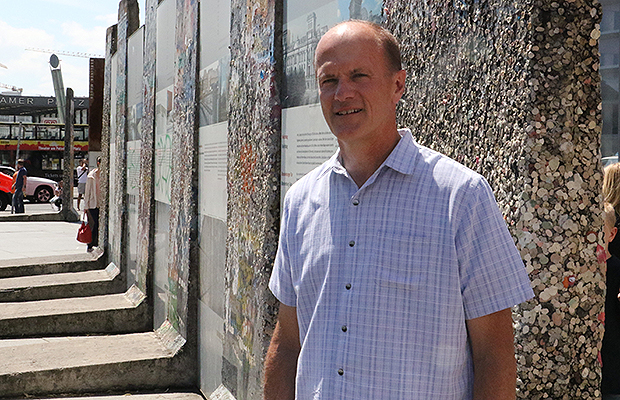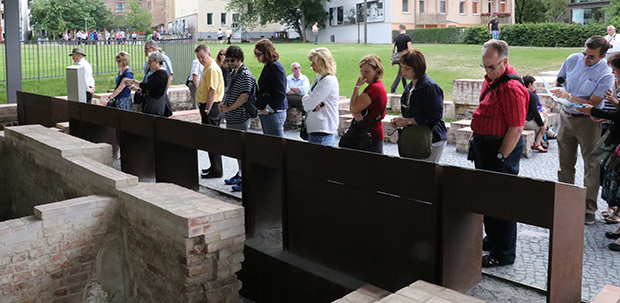Choir Begins 3-Week European Tour in Berlin, a City Steeped in Cold War History
Contributed By R. Scott Lloyd, Church News staff writer

The Mormon Tabernacle Choir and Orchestra at Temple Square perform at Berlin Philharmonie, the first venue in a three-week, seven-city tour of western Europe.
Article Highlights
- The choir received a double encore from the audience in Berlin.
- The performance was especially significant for two choir members whose parents are from Germany.
- Choir members were able to see many historical sites while in Berlin.
“I get the chance to show my American family where I’m from, why I am who I am, but I also get to show my family and friends here what I do and what I believe is true. This is a magnificent choir that brings a special, special spirit, and to be able to share that [with] my people here is wonderful.” —Sonja Sperling Poulter, a German alto in the choir
Related Links
BERLIN, GERMANY
In this city so steeped in Cold War history, the Mormon Tabernacle Choir on June 29 performed an enthusiastically received concert, kicking off the beginning of a three-week tour of western Europe. This is the choir's first international tour in 18 years, with performances scheduled in seven cities.
With its sister group the Orchestra at Temple Square, the choir played to a sold-out audience at the 2,100-seat Berlin Philharmonie. The crowd demanded two encores, then continued with rhythmic clapping even after musical director Mack Wilberg had left the stage and the singers and instrumentalists began to file out.
Choir member and musicologist Luke Howard had warned his colleagues in a memo that Europeans are sophisticated in their tastes for art and music and that even though the choir is famous, members should not take for granted they would receive the enthusiastic responses they are used to with the hometown crowds in Salt Lake City.
Even so, the audience rewarded the choir and orchestra with an instant standing ovation after the last scheduled selection, “The Spirit of God,” with exuberant clapping, cheers, and whistling that lasted nearly a full minute.
The applause was far longer and more raucous after the first encore, the choir’s signature song, “Battle Hymn of the Republic.”
“It has been such a pleasure for us to be with you this evening, and we have felt so welcomed by the good people of this beautiful and historic city,” said the choir’s announcer, Lloyd Newell, when the applause had subsided.
“We hope to see you again [more applause]. Until we do, “Gott sei mitt euch,” he said, invoking the title of the German translation of the choir’s familiar farewell hymn, “God Be with You Till We Meet Again,” which was then performed in German, to the obvious delight of the audience.

Elder L. Whitney Clayton of the Presidency of the Seventy speaks at a reception for government, civic, and religious leaders prior to the concert, with Sonja Sperling Poulter translating, on June 29. Photo by Debra Gehris, Mormon Tabernacle Choir.

The Mormon Tabernacle Choir and Orchestra at Temple Square played to a sold-out audience at the 2,100-seat Berlin Philharmonie on June 29. Photo by Debra Gehris, Mormon Tabernacle Choir.

Sonja Sperling Poulter, a member of the choir who also acted as a translator, greets her mother in Berlin, Germany, on June 28. Photo by Debra Gehris, Mormon Tabernacle Choir.

Sonja Sperling Poulter meets with her parents in Berlin, Germany, on June 29. Sister Poulter was raised in Frankfurt, Germany, until she was 26 years old, when she moved to the United States to pursue a graduate degree. Photo by Debra Gehris, Mormon Tabernacle Choir.
The first half of the concert was based on the hymn tune “Old Hundredth,” familiar to Latter-day Saints as the melody of “Praise God from Whom All Blessings Flow,” and included two songs of praise: “How Excellent Thy Name“ by Georg Friedrich Handel and Psalm 148 by Gustav Holst.
Also in the first half were the majestic Charles Gounod anthem so well received at last year’s U.S. East Coast tour, “Unfold, Ye Portals”; Gioacchino Rossini’s “Cum Sancto Spiritu”; Brother Wilberg’s own “Requiem aeternam”; William Albright’s “Agnus Dei”; Alberto Ginastera’s “Alleluia” from Psalm 148; and Johann Sebastian Bach’s “Herr, Gott, dich loben alle wir.”
The second half of the program began with a set called “World Music of Rejoicing” and included the perennial favorite “Betelehemu,” in which the choir delights audiences by moving to the music.
Associate musical director Ryan Murphy directed pieces “from the American songbook,” including “Pilgrim Song,” “Come Thou Fount of Every Blessing,” “Battle of Jericho,” “Deep River,” and “Cindy. “
Brother Newell spoke through interpreter Sonja Sperling Poulter, an alto in the choir who was born to German parents. In a reception for government, civic, and religious leaders prior to the concert, she also interpreted for choir president Ron Jarrett and for Elder L. Whitney Clayton, the senior member of the Presidency of the Seventy, who is the General Authority adviser traveling with the choir and orchestra for the first portion of the tour.
In an interview, Sister Poulter said she was born in Canada when her father was stationed there with an employer, but she was reared in Frankfurt, Germany, where she lived until age 26, when she moved to the United States to pursue a graduate degree.
“I’m coming home,” she said of her return to Germany with the choir. “I get the chance to show my American family where I’m from, why I am who I am, but I also get to show my family and friends here what I do and what I believe is true.”
She added, “This is a magnificent choir that brings a special, special spirit, and to be able to share that [with] my people here is wonderful.”

Ron Jarrett, Mormon Tabernacle Choir president, speaks at a pre-concert reception as Sonja Sperling Poulter, a choir member of German parentage, interprets. Photo by R. Scott Lloyd.
She said she remembers the choir coming to Germany in 1991, when she was 7. “It was the coolest thing ever that the choir would come from America to sing for us. And now to be part of them on the other side is just magnificent.”
Both her parents came from Frankfurt to attend the concert.
In remarks at the reception, Elder Clayton reflected on that 1991 concert and said the choir had come to Germany before then.
“The first time was in 1955,” he said. “The choir sang here and in Wiesbaden. Eighteen years later, in 1973, the choir came again and sang that time in Munich and Oberamergau. As you know, they visited again in 1991 and performed in Frankfurt, Dresden, and Berlin. It took 25 years to get them back.”
Holgar Rakow, chairman of the reception committee, spoke of that occasion.

Mack Wilberg directs the Mormon Tabernacle Choir and the Orchestra at Temple Square at the Berlin Philharmonie on June 29. Photo by Debra Gehris, Mormon Tabernacle Choir.
“That day, the German Bundestag met and made the decision that Berlin should be the capital of Germany,” he said, speaking through Sister Poulter as interpreter. “This result was announced during the encore of the choir concert. Everybody that was in attendance at the concert gets goose bumps thinking about it.”
Earlier that day, and the day before when they arrived in Frankfurt, choir and orchestra members and their guests saw the remains of the Berlin Wall, perhaps the most iconic and ominous symbol of the Cold War, when East Germany—and East Berlin—were controlled by the Soviet Union, with the wall dividing the city .
Much of the wall has been dismantled since 1989, the beginning of the dissolution of Soviet Union. Iron posts mark the footprint where the now-dismantled portions of the wall stood.
A monument marks the foundation of the Reconciliation Church, which had stood inaccessible amid the border fortifications since 1961, when the wall was erected, until 1985, when the government of East Germany had the church nave and then the tower blown up.

Iron poles marking the footprint of some of the dismantled Berlin Wall frame a group of participants of the Mormon Tabernacle Choir and Orchestra at Temple Square July 29, 2016. Photo by R. Scott Lloyd.
Tour participants also visited the storied Brandenburg Gate, one of the best-known landmarks of Germany, partly because of its Cold War connection, its proximity to “Checkpoint Charlie,” one of eight border crossings which was eventually closed “until further notice” by the East German government and which remained closed until the dismantling of the wall.
Choir member David Fisher’s parents, Hans and Helga, were residents of East Berlin in 1954 during the Cold War and escaped to the west.
“At that time you could cross back and forth, but if you wanted to leave East Berlin, you couldn’t take anything with you. So they had to sneak all their clothes out in a baby buggy. They could kind of feel what was coming so they decided to leave.”
His father’s parents came along, though one brother remained in Berlin. Brother Fischer’s family in Berlin today stems from that brother.
Brother Fischer, who today lives in Highland, Utah, would not be born until 1950, but his eldest brother was born at the time the family escaped.
“They laid him out in a baby buggy, and they’d fold clothes over him. They would go back and forth until they left.”

Sister Kathy Ann Kipp Clayton (holding sheet music), wife of Elder L. Whitney Clayton, sits in with the Mormon Tabernacle Choir during rehearsal and sound check June 29 prior to a concert at the Berlin Philharmonie. Photo by R. Scott Lloyd.

Members of the Mormon Tabernacle Choir and Orchestra at Temple Square leave sound check and rehearsal at the Berlin Philharmonie prior to their concert that evening. Photo by R. Scott Lloyd.

Members of the Mormon Tabernacle Choir and Orchestra at Temple Square enter the Berlin Philharmonie prior to their concert. Photo by R. Scott Lloyd.

Lloyd Newell speaks at the Berlin Philharmonie with Sonja Sperling Poulter translating on June 29. Photo by Debra Gehris, Mormon Tabernacle Choir.

Harpist Tamara Oswald and flautist Jeannine Goeckeritz of the Orchestra at Temple Square perform at a reception for government, civic, and religious leaders prior to the concert on June 29. Photo by Debra Gehris, Mormon Tabernacle Choir.

Interior of a monument that marks the foundation of the Reconciliation Church, which had stood inaccessible amid the border fortifications since 1961, when the wall was erected, until 1985, when the government of East Germany had the church nave and then the tower blown up. Photo by R. Scott Lloyd.

David Fischer, Mormon Tabernacle Choir member, stands near the Berlin Wall monument at Potsdamer Plats, a historic thoroughfare in the heart of Berlin. His parents left East Berlin in 1954, taking their belongings out little by little in a baby buggy. Photo by R. Scott Lloyd.

Participants on the Mormon Tabernacle Choir and Orchestra at Temple Square tour view information panels marking foundations of apartment buildings along the East and West Berlin border where the wall was built, requiring the buildings to be dismantled and occupants removed. Photo by R. Scott Lloyd.

A monument marks the foundation of the Reconciliation Church, which had stood inaccessible amid the border fortifications since 1961, when the wall was erected, until 1985, when the government of East Germany had the church nave and then the tower blown up. The cross in the foreground was twisted by the explosion. Photo by R. Scott Lloyd.
